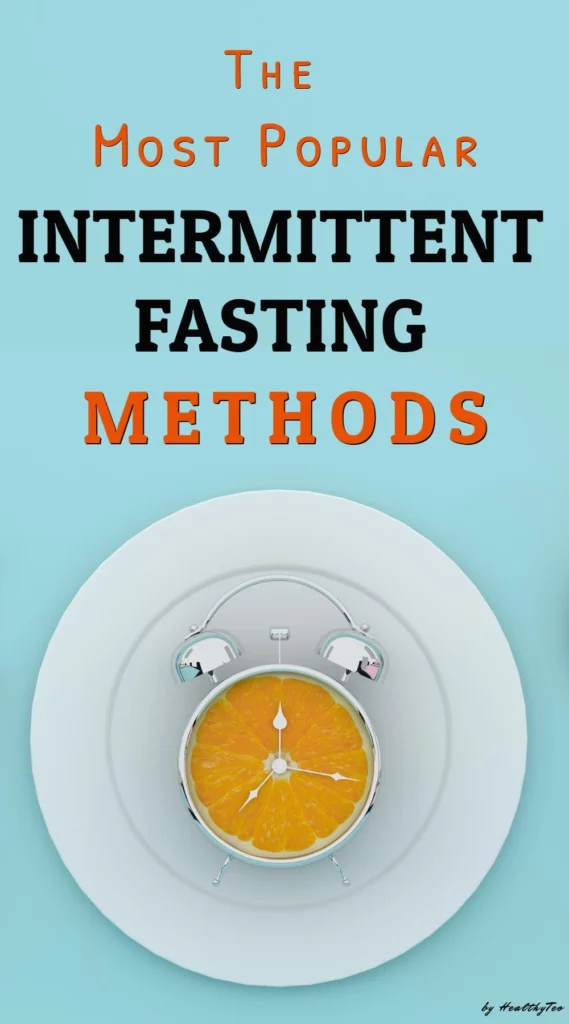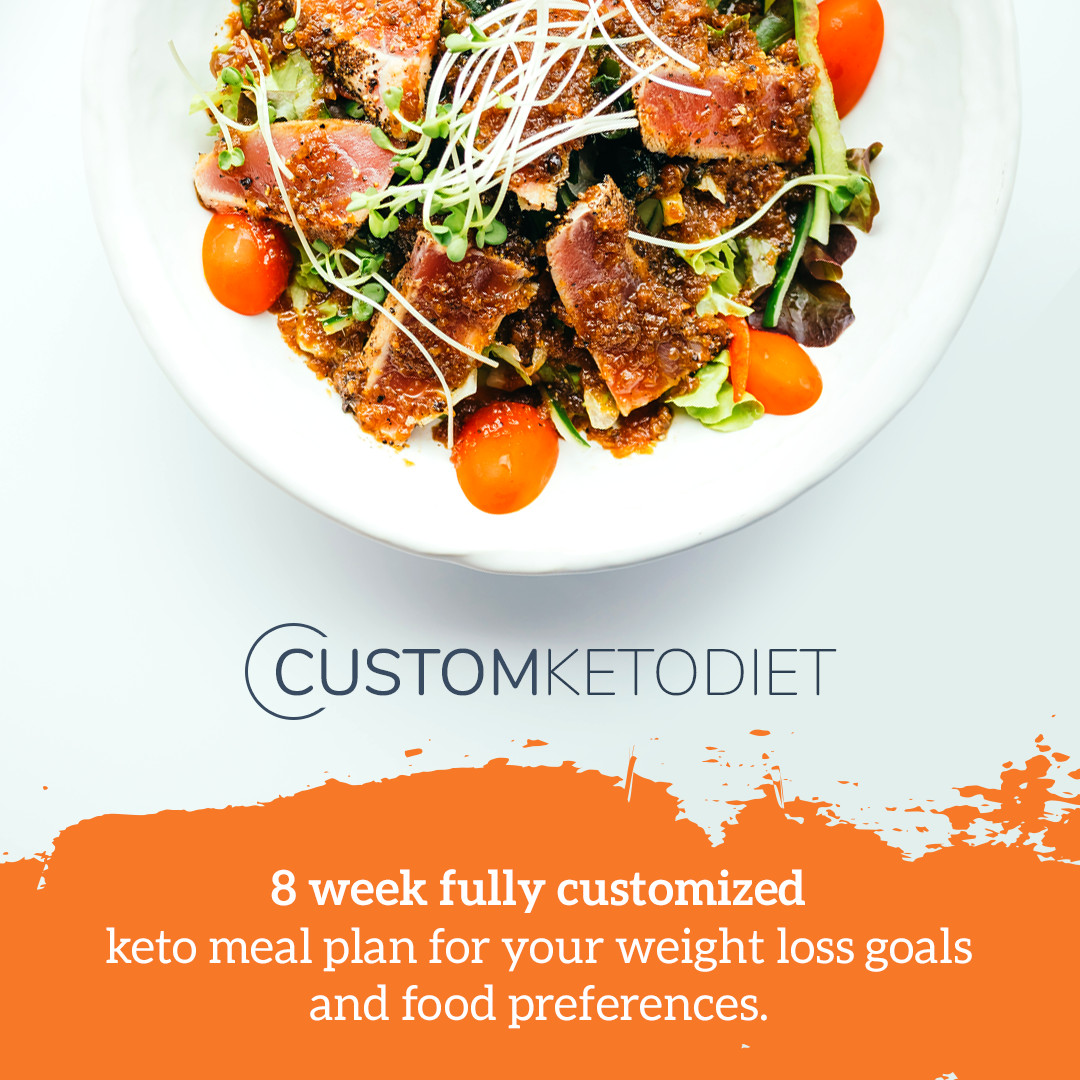Popular ways to do intermittent fasting
There are multiple intermittent fasting methods, with the main differences being the number of fast days and the calorie allowance. Every method can be effective, but it is not appropriate for everyone.
Each person’s intermittent fasting experience is unique, and different types of intermittent fasting will suit different people.
Before we go over the various methods of intermittent fasting, you should know that fasting is not for everyone, and if you decide to try one of these methods of intermittent fasting, you should first consult with your healthcare provider!
This post may contain affiliate links, which means we may receive a small commission, at no cost to you, if you make a purchase through a link. For more information, please see our disclosure.
Popular intermittent fasting methods
There are many different methods of intermittent fasting. Here are the most popular that many people practice:
The 16/8 method
The 16/8 intermittent fasting method is one of the most practiced types of intermittent fasting. People sometimes call it a 16:8 plan or 16/8 diet.
On the 16/8 intermittent fasting method, you fast (abstaining from food) for 16 hours a day and you consume food and drinks during the remaining 8 hours.
Many people who follow the 16/8 plan abstain from food at night and for part of the morning and evening. They consume their daily calories during the middle of the day.
If we simplify this it means that on this method of fasting you will not eat anything after dinner and skip breakfast. For example, if you finish your last meal at 8 p.m. don’t eat until noon the next day, you are technically fasting for 16 hours.
If you are interested in this fasting type you can learn more by visiting this article about 16/8 intermittent fasting: what is it and how to follow!
It is good to know that on the 16/8 fasting method and other intermittent fasting methods you should consume zero-calorie beverages during your fast time. You should do this to stay hydrated and reduce feelings of hunger.
When it’s time to eat, on this type you have an 8-hour eating window. Try to eat healthier food. Avoid consuming processed and junk food.
If you decide to follow the 16/8 intermittent fasting method or any other type of fasting it is good to know what foods to eat.
So, here is a further reading for you about the foods to eat and avoid on 16/8 intermittent fasting!
Fast for 12 hours (Overnight fasting)
Also known as the 12/12 method, this type of intermittent fasting is suitable for beginners to give a whirl. The rules here are simple, you fast for 12 hours each day.
Because the fasting window is relatively small, this intermittent fasting method is ideal for beginners. The majority of fasting occurs while sleeping.
The easiest way to do the 12-hour fast is to include the period of sleeping in the fasting window.
For example, you can choose to fast between 8 p.m. and 8 a.m. You would need to finish your last meal before 8 p.m. and wait until 8 a.m. to eat your first meal. You would be asleep for much of the time between.
You might even already be doing the overnight fast without even knowing!
An advantage of this method is that is simple to implement and you don’t have to skip meals. All you’re doing is eliminating a bedtime snack.
Despite the fact that is a good start point if you’ve never fasted before, this method of IF doesn’t maximize the advantages of fasting.
If your goal is losing weight by practicing intermittent fasting, a smaller fasting window means more time to eat. This means that you probably won’t decrease the number of calories you consume!
So, the 12/12 method or overnight fasting is good for beginners but you probably won’t reap all the benefits from intermittent fasting.
The 5:2 diet
The 5:2 diet is also one of the most practiced intermittent fasting methods.
It’s called the 5:2 diet because five days of the week are normal eating days, and on the remaining two days you restrict your calorie intake to just 500-600 per day.
On fasting days, women should consume 500 calories and men should consume 600. You can choose which two days of the week you will consume the calorie-restricted amount. Between them, there must be at least one non-fasting day.
For example, you could fast on Mondays and Thursdays and eat normally the other five days of the week. It is up to you to decide which two days of the week you will fast.
It is critical to understand that when we say “eat normally on non-fasting days,” we do not mean “eat junk and processed food.” If you binge on junk food, you will most likely not lose weight and may even gain weight.
Try to eat more healthful meals, and the volume of food you eat on non-fasting days should be the same as if you hadn’t fasted at all.
This is a very popular intermittent fasting method and if you want to go deeper and learn more about this eating protocol here is a further reading for you about the 5:2 diet, how to start and what to expect!
Eat Stop Eat ( a weekly 24-hour fast )
The Eat Stop Eat diet is a method of intermittent fasting that involves a 24-hour fast once or twice a week.
For example, you could choose one or two non-consecutive days per week to go without eating for a full 24-hour period. Then you can eat as much as you want (responsibly) for the remaining 5 or 6 days of the week.
There is a lot of evidence that supports the benefits of fasting once a week; to learn more, read this article about the benefits of fasting for 24 hours.
So, if you finish dinner at 8 p.m. on Monday and don’t eat dinner until 8 p.m. on Tuesday you’ve completed a 24-hour fast. This is just an example you can fast from breakfast to breakfast or lunch to lunch. It’s up to you to decide.
You must stay hydrated on your fasting day. Water, black coffee, unsweetened tea, and other calorie-free drinks are allowed and should be consumed. Solid foods are not allowed during your 24-hour fast.
There is a lot to say about this method of intermittent fasting, and you can learn more about it here, such as how the Eat Stop Eat diet works, what to eat, and the potential benefits and side effects of following it.
Alternate-day fasting
On this form of intermittent fasting, you fast every other day and eat whatever you want on non-fasting days.
You can also practice a modified alternate-day fasting approach, in which you consume 500 calories on fasting days or 20-25 percent of your daily energy requirements.
Because it is difficult to go every other day without eating, many people opt for a modified approach in which they can eat on fasting days but limit their calorie intake.
According to a small study published in the Nutritional Journal, alternate day fasting was effective in assisting obese adults to lose weight. Side effects such as hunger subsided by week two, and participants began to feel more satisfied with the diet by week four.
The downside is that participants said they were never truly “full” during the eight weeks of the experiment, which can make sticking to this approach difficult.
Alternate Day Fasting is a very extreme type of intermittent fasting that should not be attempted by beginners or those with certain medical conditions.
This method may cause you to go to bed hungry several times per week. So this is not very pleasant, and it may be difficult to maintain this type of fasting for an extended period of time.
The Warrior Diet
The Warrior Diet, also known as 20/4 fasting, is an extreme form of intermittent fasting.
It entails eating very little, only a few servings of raw fruits and vegetables over a 20-hour fasting period. Then, at night, you eat one large meal. The eating window is usually only 4 hours long.
People should consume plenty of vegetables, healthy fats, protein, and carbohydrates during the 4-hour eating period.
Anyone who wants to start eating this way should stick to an initial three-week, three-phase plan that will allow your body to adjust to the changes you are making.
To learn more about this extreme intermittent fasting, read this detailed article about the Warrior Diet, which includes information about the foods to eat as well as potential side effects.
We call this an extreme form of intermittent fasting because it can be difficult to follow the strict guidelines on when and what to eat on a long-term basis. Also, some people may find it difficult to eat such a large meal so close to bedtime.
The Warrior Diet is not for beginners. It is highly restrictive, not suitable for many people. May lead to potential side effects such as irritability, fatigue, insomnia, etc.
Spontaneous meal skipping
Spontaneous fasting, also known as meal skipping, is simply skipping meals on occasion, such as when you are not hungry or are too busy to cook and eat.
This adaptable approach to intermittent fasting may be beneficial to beginners.
This is one type of intermittent fasting that is recommended for anyone who is unsure about intermittent fasting or who feels overwhelmed by setting strict fasting times.
Meal skipping is most likely to be successful when people monitor and respond to their bodies’ hunger signals.
So, if you’re not hungry one day, skip breakfast and eat a healthy lunch and dinner instead. Just keep in mind that eating healthy foods at each meal is essential.
Spontaneous fasting or skipping meals when not hungry is an effective way to recondition the widely held belief that we must eat three meals per day.
You will not go hungry if you skip a meal every now and then! Just remember to eat well-balanced meals during the non-fasting period!
Who shouldn’t try intermittent fasting
Intermittent fasting is not for everyone. A few groups of people should NOT try it.
The people listed below should not try intermittent fasting:
People who have a history of disordered eating or eating disorders – Intermittent fasting may not be a good choice for anyone who has had a history of disordered eating or an eating disorder.
If you’re doing intense training or trying to gain muscle mass – Trying to do intermittent fasting while on an intense training cycle is not a good idea.
To help you power through your workout, you should eat something before you begin. It’s also important to eat something after you’ve finished exercising.
You work a job that requires intense focus and concentration – While some people report increased energy from intermittent fasting, others may experience fatigue, decreased concentration, and low energy levels.
If your job requires a lot of energy and concentration, intermittent fasting might not be for you.
People with diabetes – If you have diabetes or currently taking diabetes medications, you should never do intermittent fasting without first consulting with your doctor.
Anyone who suffers from low blood sugar should avoid IF because it is critical for them to consume food on a regular basis in order to maintain adequate blood sugar levels.
Women who are pregnant, trying to become pregnant, or breastfeeding – Pregnancy and breastfeeding necessitate an adequate calorie intake for the baby’s development and milk production.
Fasting periods will interfere with your caloric intake. As a result, pregnant and breastfeeding women should NOT practice intermittent fasting.
If you have a weak immune system – Those who have recently experienced or are currently dealing with a major illness should not engage in intermittent fasting without first consulting with a doctor.
Avoid intermittent fasting if you have higher caloric needs – Individuals who are underweight, struggling with weight gain, or are under the age of 18 should NOT try an intermittent fasting diet, as they need sufficient calories on a daily basis for proper development.
These individuals should avoid intermittent fasting. Aside from the benefits of practicing one of the intermittent fasting methods, there are some side effects that you should be aware of.
If you want to learn more, here’s a detailed article on the side effects of intermittent fasting.

Final thoughts on the most popular intermittent fasting methods
Some of the most popular intermittent fasting methods are:
- The 16/8 method
- Overnight fasting
- The 5:2 diet
- Eat Stop Eat ( a weekly 24-hour fast)
- Alternate day fasting
- The Warrior diet
- Spontaneous meal skipping
Each of these types of intermittent fasting is distinct. Some of them necessitate greater self-discipline, while others are simpler to follow.
If you want to try one of these intermittent fasting methods, you should first consult with your doctor. Your healthcare provider will advise you on what is best for you and whether you should use one of the intermittent fasting methods.
As previously stated, there are some negative consequences to practicing intermittent fasting, and many people should avoid it. So, the best thing to do is to first consult with your doctor!
For more information, read our article on the fundamentals of intermittent fasting and how to get started!




